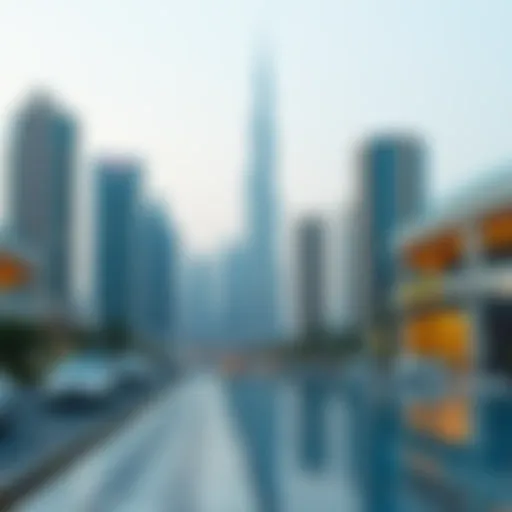Exploring Normal Residential Designs in Dubai
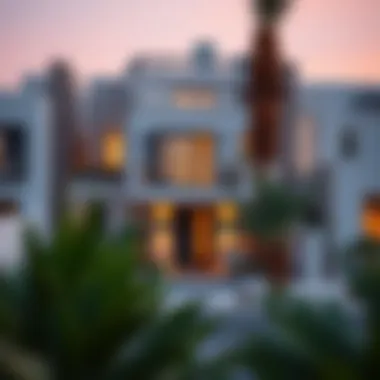
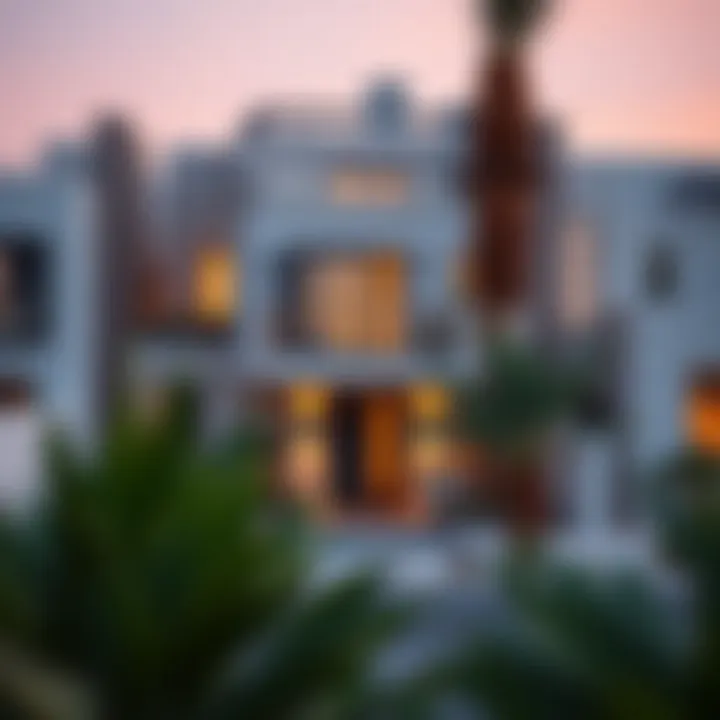
Intro
Dubai houses display a fascinating mix of tradition and modernity, reflecting its position as a melting pot of cultures. While the city is often highlighted for its lavish skyscrapers and luxury villas, the ordinary homes are equally significant in understanding the local architectural landscape.
In this exploration, we will navigate the themes of design influenced by climate, culture, and socio-economic factors, laying bare the nuances behind these homes. We aim to provide insights for future homeowners and investors who view Dubai not just as a hotspot for opulent living but as a viable market for diverse housing options.
Property Listings Overview
As the heart of the UAE, Dubai boasts a unique property market where ordinary houses wear the warmth of community and culture amidst the bustling urban life.
Current Market Trends
Despite the global downturns that have shaken various markets, Dubai's real estate sector shows resilience. The allure of Dubai continues to attract expatriates and investors alike, as it combines luxury with affordability in specific neighborhoods. Properties in areas like Jumeirah Village Circle and Dubai Silicon Oasis can often be found at more accessible price points, enabling potential homeowners to break into the Dubai market. Current trends indicate that family-oriented neighborhoods are seeing a surge with demand for properties that accommodate not only the living requirements but also offer community amenities such as schools and parks.
Featured Properties
For a closer look at the ordinary houses that define the spirit of Dubai, a variety of options exist — from modest townhouses to spacious family villas.
- Jumeirah Village Circle: Known for a blend of sophisticated and functional layout, houses here typically flaunt spacious gardens and room for pets, making it a desired locale for families.
- Dubai Silicon Oasis: This area is recognized for its cutting-edge technoligcal developments and affordable housing options, catering to young professionals.
- Arabian Ranches: Offering an oasis-like environment, this neighborhood is ideal for those seeking a tranquil lifestyle away from the din of the city while still maintaining access to urban facilities.
Buying Guide
Navigating the property market in Dubai can be overwhelming due to so many options and legalities. However, having a clear pathway can make the process smoother.
Steps to Purchase
- Research: Start by identifying neighborhoods that align with your personal and financial goals.
- Financial Planning: Calculate your budget, taking into account not just the purchase price but also ancillary costs like registration and maintenance.
- Engage an Agent: A local real estate agent can provide invaluable insights and help navigate the paperwork.
- Property Viewing: Always visit and inspect properties. Pictures can only tell so much.
- Finalizing the Deal: Once you’ve chosen a house, scrutinize the sale agreement, ensuring all conditions are favorable.
Key Considerations for Investors
Investing in Dubai's residential market isn’t just about purchasing a property. Key points to ponder include:
- Accessibility: Proximity to public transport and major roads can significantly impact property value.
- Community Amenities: Initially, this could influence your living experience, but in the long run, it boosts resale value.
- Rental Potential: Evaluate areas with a good mix of rentals to ensure steady income.
"Understanding the local culture and regulations is crucial when venturing into the Dubai property market. A wise investor knows that knowledge is as valuable as capital."
With these insights, it becomes easier to approach the market with confidence, facilitating well-informed decisions. By understanding both the allure and practical considerations of ordinary houses in Dubai, potential homeowners and investors are better equipped to find their ideal place in this vibrant city.
Understanding Dubai's Housing Market
The housing market in Dubai is a dynamic realm, shaped by a complex tapestry of cultural influences, economic shifts, and architectural trends. Understanding this market is crucial for anyone looking to invest in real estate, as it provides insight into the underlying factors driving property values and consumer preferences. For potential homeowners, the nuances of this market can mean the difference between an astute purchase and a regrettable financial decision.
Dubai has transformed into a global metropolis over the past few decades, attracting a diverse population and significant investment from expatriates and corporations alike. This influx has not only led to an increased demand for housing but has also influenced the types of residences that are built. By understanding how the interplay between culture, economy, and architecture shapes Dubai’s housing landscape, investors can make informed decisions and anticipate future trends.
In this article, we will explore the historical context behind Dubai's housing development, analyze the economic conditions influencing housing demand, and conduct a comparative analysis between luxury and normal houses. These elements provide essential context for anyone contemplating a move to this sprawling city or looking to invest in its ever-evolving property market.
Historical Context of Dubai's Housing Development
Dubai's journey from a modest fishing village to a booming global city is fascinating. The discovery of oil in the 20th century catalyzed unparalleled growth and urbanization. The government recognized the need for housing as the population surged, leading to significant investments in infrastructure and residential developments. Over time, various initiatives promoted the construction of both luxury and affordable homes, catering to the needs of a diverse urban population.
As Dubai's economy diversifies, housing developments have also adjusted to reflect modern lifestyle demands, blending traditional influences with contemporary designs. Understanding this history is vital, as it informs current housing options and investment opportunities in the city.
Economic Factors Influencing Housing Demand
Several economic factors play crucial roles in shaping the demand for housing in Dubai. These include the thriving expatriate community, specific government regulations, and global economic fluctuations.
Impact of expatriate population
The impact of expatriates on Dubai's housing market cannot be overstated. With a large portion of the city's residents being foreigners, demand for family-friendly, affordable homes has surged. This diverse population is looking for various housing options that balance comfort with affordability. The competitive nature of the market also drives the development of new accommodations, ensuring a rapidly evolving landscape that offers something for everyone.
A key characteristic of the expatriate influence is their preference for communities that offer safety, accessibility to amenities, and a sense of belonging. Areas like Jumeirah, which provide a touch of coastal living without the heftier price tags of luxury neighborhoods, have become particularly popular. This market behavior creates a unique dynamic that continually shapes the residential offerings available in Dubai.
Government regulations and policies
Government policies have played a pivotal role in shaping Dubai's housing landscape. The city’s leaders have worked diligently to make real estate accessible to a broad audience, including expatriates and foreign investors. One significant policy is allowing expatriates to buy property in designated areas, a move that spurred tremendous growth in the housing sector.
Market regulations are designed to safeguard investment and maintain stability. For instance, initiatives aimed at affordable housing are often tailored to cater to the needs of the middle-income demographic. This accessibility creates a robust market where both buyers and renters find manageable options without compromising on quality.
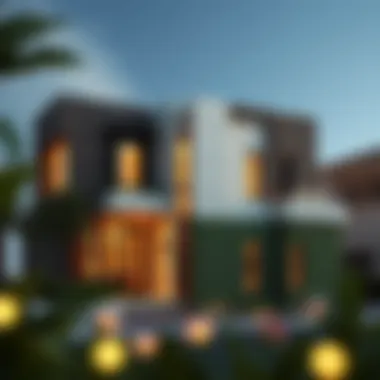

Global economic trends
Global economic trends undeniably impact Dubai's housing market. Ongoing shifts in international economies can lead to fluctuations in demand for properties, influenced by foreign investment patterns. For instance, when economic conditions are favorable, there tends to be an increase in luxury developments, while downturns may see a shift towards more affordable housing solutions.
One unique aspect of Dubai is its resilience to global crises. The Emirate has often adopted innovative strategies to sustain growth, promoting itself as a safe haven for investments. This adaptability has highlighted Dubai’s strengths as a stable market, making it appealing to prospective investors looking for safer havens amid global uncertainty.
Comparative Analysis: Luxury vs. Normal Houses
In any housing market, understanding the distinction between luxury and normal houses is key to making informed real estate investments. Dubai is no exception. Luxury houses are often seen as status symbols, showcasing opulence with high-end finishes and prime locations. In contrast, normal houses, though often overlooked, offer practical options for many residents, striking a balance between comfort and budget.
Normal houses cater to a variety of needs, including family-oriented communities, enhancing social dynamics within neighborhoods. Analyzing the features and benefits of both housing types is essential for understanding the broader dynamics of Dubai's housing landscape and making an informed decision that aligns with individual goals and preferences.
Architectural Styles of Normal Houses
Understanding the architectural styles found in normal houses across Dubai is more than just an exploration of aesthetics; it is a representation of the city’s diverse culture, climate, and social dynamics. In this dynamic city, the blend of contemporary design and traditional influences shapes not only the skyline but also the daily lives of residents. People consider architectural styles not simply as buildings but as living spaces that reflect personal identity and community heritage, thus influencing their decisions when it comes to buying or renting a home.
Contemporary Designs in Normal Housing
Minimalist aesthetics
When discussing contemporary designs, minimalist aesthetics stand out as a crucial factor. This approach is characterized by simplistic lines and an absence of unnecessary embellishments. Minimalist homes in Dubai often utilize open spaces, allowing for greater interaction with natural light and the surrounding environment. This style is regarded as timeless and efficient.
The key characteristic here is the idea of 'less is more.' By stripping away excess, minimalist designs create a sense of tranquility and simplicity, appealing to a broad range of residents, especially younger expatriates and families seeking functional environments without clutter.
- Benefits: The clean lines and clear spaces make homes feel larger and more welcoming. Maintaining such spaces tends to be simpler as well.
- Challenges: Over-simplicity can sometimes lead to a lack of warmth or personality, which may not appeal to everyone.
Use of sustainable materials
Turning to sustainable materials, this aspect is gaining traction in the construction of normal houses in Dubai. Environmentally friendly resources such as bamboo, recycled glass, and rammed earth not only contribute to energy efficiency but also positively impact the home’s carbon footprint.
Many homeowners now see sustainability as a necessary investment rather than just a trend. These materials often contribute to energy savings and have a lower impact on the environment, making them appealing for eco-conscious buyers.
- Benefits: Using sustainable materials often leads to lower utility bills and a longer lifespan for the building itself.
- Challenges: There can sometimes be higher upfront costs, and sourcing these materials may be limited in certain areas.
Traditional Influences on House Design
Arabic architectural elements
Arabic architectural elements bring rich history and cultural significance to normal houses in Dubai. These influences can often be seen in ornamental arches, intricate arabesque patterns, and traditional courtyard layouts. These design features not only enhance aesthetic appeal but also foster a sense of community and connection to cultural heritage.
- Benefits: Such designs create inviting spaces that encourage social interaction among neighbors.
- Challenges: Some may find traditional elements too ornate for their tastes, viewing them as less versatile for modern living.
Fusion with modern techniques
The fusion between traditional styles and modern techniques presents a unique approach to housing in Dubai. Combining classical Arabic designs with contemporary construction methods, this blend offers an innovative take on living spaces. With open layouts and large windows, these homes maintain the cultural essence while catering to modern lifestyles.
- Benefits: This blend can be visually striking and provides the comfort and convenience of modern housing, offering the best of both worlds.
- Challenges: Striking the right balance can be difficult, and there is a risk of diluting the traditional elements if not executed carefully.
Impact of Climate on Housing Architecture
Climate plays a significant role in shaping architects' designs in Dubai, where the weather can be harsh and extreme. Hence, houses often feature materials and layouts that promote cooling and energy efficiency. Strategies include thick walls, high ceilings, and strategic window placements to allow airflow.
In summary, the architectural styles of normal houses in Dubai reveal a rich tapestry woven from tradition and modernity. From minimalist approaches to sustainable materials, the designs encapsulate the essence of living in a city that thrives on contrast yet strives for harmony.
Key Neighborhoods with Normal Houses
Understanding the key neighborhoods in Dubai housing not only paints a picture of the city's architectural diversity but also reflects the socio-economic fabric that makes up the community. Normal houses in these neighborhoods provide insight into daily life, cultural dynamics, and the preferences of expatriates and locals alike. Each area offers unique characteristics, advantages, and challenges that prospective buyers and investors should consider.
Al Quoz: The Artistic Hub
Al Quoz stands out as a vibrant artistic enclave within a bustling metropolis. Originally industrial, it has recently transformed into a hub of creativity, drawing artists, designers, and culturally-minded individuals. Among the ordinary houses, you can find a mix of residential villas and stylish lofts that embody a bohemian flair, making the neighborhood appealing for those who value artistry and innovation.
Living in Al Quoz brings certain benefits. For one, it's a stone's throw away from contemporary art galleries, cafes, and cultural spaces like the Alserkal Avenue. This lets residents immerse themselves in a thriving creative environment that fosters social engagement. However, the rapid evolution of this neighborhood brings challenges such as rising property prices and the pressure of gentrification.
As such, many families and young professionals are looking for houses that resonate with their passion for creativity while still maintaining a sense of home. Investing in Al Quoz, despite its higher price tag, may see significant returns as it continues to attract a diverse crowd.
Deira: A Blend of Tradition and Modernity


Deira gives a taste of Dubai's heritage with a strong infusion of modern living. Known for its bustling markets and vibrant streets, normal houses in Deira tend to carry a sense of history while accommodating the evolving lifestyle of its residents.
One can look at the cozy apartments and older homes that harmonize with the lively souks, where residents mingle with visitors, making it a unique experience to live here. The melding of the old and the new gives Deira its charm, providing a rich cultural backdrop that appeals to families and expatriates searching for an authentic Emirati experience.
Furthermore, Deira offers practicality, with its extensive public transport links and abundance of shops and restaurants. Yet, with its advantages, living here could come with inconveniences like traffic congestion and noise due to the busy marketplaces. Therefore, those looking for properties in Deira should weigh the benefits of cultural immersion against the hustle and bustle that define this historic part of the city.
Jumeirah: Coastal Living Without Excess
Jumeirah captures the essence of coastal living without the spotlight often associated with luxury. While many know it for its beachfront mansions, the normal houses nestled among its palm trees and sandy shores provide a different narrative—affordable homes in a picturesque locale.
Properties here are often family-friendly, reflecting the laid-back lifestyle that Jumeirah promotes. With access to pristine beaches and community parks, this neighborhood attracts families wishing for a serene environment that provides both relaxation and recreation.
Living in Jumeirah comes with a plethora of advantages, from diverse dining options to high-quality schools and excellent healthcare facilities. Certainly, some may argue that its distance from the financial district could be a drawback. However, what it lacks in proximity, it mostly compensates with its quality of life.
In summary, while searching for normal houses in Dubai, one cannot overlook the significance of these neighborhoods. They offer distinct lifestyles, community engagement, and investment potential. Each area presents unique opportunities and challenges, allowing prospective buyers to tailor their choices based on personal values and requirements in the bustling context of Dubai.
Affordability and Investment Potential
Understanding the affordability and investment potential of normal houses in Dubai is crucial for anyone looking to navigate this complex housing market. It's not just about looking at the numbers; it's about grasping the broader implications of these factors. For prospective buyers, investors, and even real estate agents, knowing how much property costs, and the potential for appreciation in value can influence decision-making significantly. This section breaks down the price dynamics, investment opportunities in developing areas, and the dichotomy between buying and renting.
Price Points for Normal Houses
Normal houses in Dubai showcase a wide range of price points, reflecting the city's eclectic mix of neighborhoods and architectural styles. While a luxury villa may effortlessly command millions, a typical family home can be acquired for much less, sometimes starting from around 1.5 million AED in areas like Al Quoz or Jumeirah Village Circle. Let's look at a few key factors affecting these price points:
- Location Matters: Houses situated in neighborhoods closer to the city center or beaches, like Jumeirah or Dubai Marina, often attract higher prices.
- Market Trends: Fluctuations based on supply and demand can impact prices significantly. It's essential to stay updated with local market analyses.
- Size and Amenities: Larger homes or those with additional features like swimming pools or private gardens typically come at a premium.
It’s helpful to keep an eye on online listings and consult local real estate experts for the most accurate and up-to-date information regarding these price ranges.
Investment Opportunities in Up-and-Coming Areas
Dubai is ever-evolving, and the emergence of up-and-coming areas presents unique investment opportunities. These neighborhoods often offer lower entry prices with significant potential for appreciation, making them appealing to both first-time investors and seasoned property owners. Consider these suggestions:
- Dubai South: Envisioned as a futuristic city, prices here are still relatively affordable. The area houses the Al Maktoum International Airport, and as development continues, property values are expected to soar.
- Dubai Sports City: This area combines residential and commercial developments. Its sporting facilities and community vibe make it a prime choice for families, and properties are still reasonably priced.
- The Springs and Meadows: Also on the radar, these vibrant communities are ideal for retirees and families alike. As more people realize the value of living here, property investments could appreciate.
Investing in these neighborhoods can yield financial returns down the line, but engaging local real estate experts for on-ground insights is advisable.
Buying vs. Renting: Weighing the Options
When contemplating your living arrangements in Dubai, the decision between buying and renting can feel like a game of chess. Each option has its merits and caveats. Here’s a breakdown:
Buying:
- Pros:
- Cons:
- Long-term investment; property values appreciate over time.
- Freedom to customize your space as you wish.
- Stable living costs against rising rental prices.
- Significant upfront costs, including down payments and transfer fees.
- Maintenance costs can add up over time.
Renting:
- Pros:
- Cons:
- Flexibility to relocate without the long-term commitments of owning property.
- Generally lower immediate costs compared to buying.
- No concerns about property upkeep.
- Rent can increase with renewal terms, creating financial unpredictability.
- No equity build-up; the money spent on rent does not contribute to future asset ownership.
Ultimately, the decision to buy or rent should hinge on one’s financial situation, lifestyle preferences, and long-term goals. By thoughtfully considering these elements, prospective homeowners can better position themselves in Dubai's vibrant housing market.
Lifestyle Considerations in Dubai
Understanding lifestyle considerations within the context of normal houses in Dubai is crucial for several reasons. It not only affects the choice of a residence but also plays an essential role in the day-to-day experiences of families and individuals living in this vibrant city. Factors such as community amenities, cultural dynamics, and family-friendly options create an intricate tapestry that potential homeowners must analyze when considering their next purchase or rental.
Community Amenities and Services
Living in Dubai offers a rich array of amenities that elevate the standard of living. Many neighborhoods are designed with the idea of convenience in mind, ensuring that residents have easy access to everything they need.
- Parks and Recreation: In areas like Jumeirah and Al Quoz, well-maintained parks provide green spaces for families and individuals to unwind. Playground facilities and outdoor fitness areas are key attributes in attracting new residents.
- Education: Close proximity to schools is often a top priority for families. For instance, the schools in the Al Safa area have been known to deliver quality education, which can heavily influence property value.
- Healthcare: Access to hospitals and clinics stands out as another essential factor. Neighborhoods equipped with healthcare services enable residents to have a peace of mind about their well-being.
- Shopping and Dining: Retail centers and diverse dining options add to the allure of living in these neighborhoods. Whether it's small local shops or expansive malls, having shopping nearby is an advantage that cannot be overlooked.
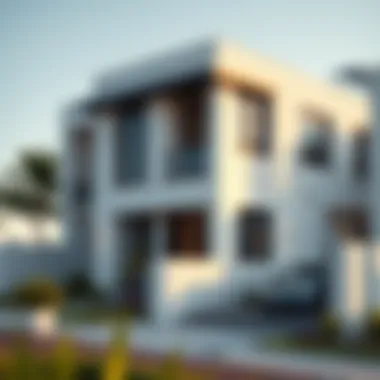
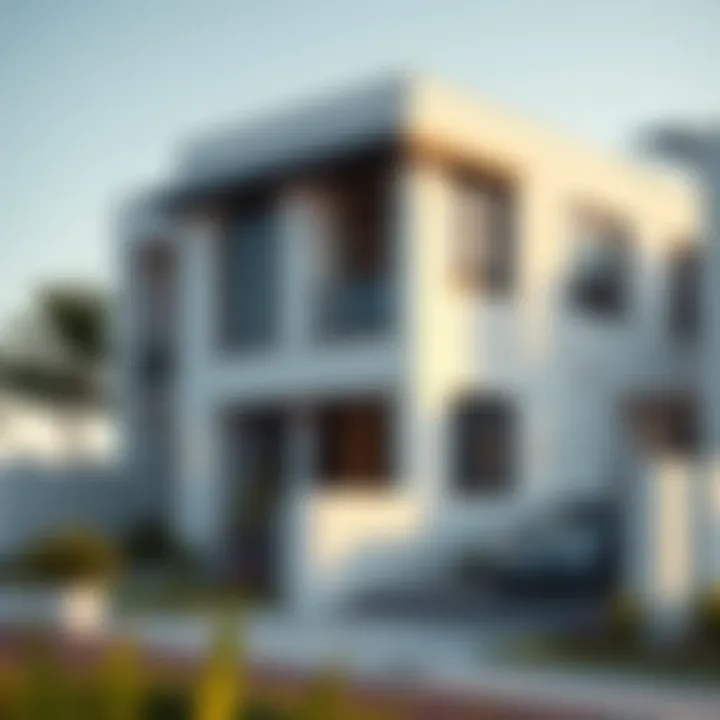
Cultural Dynamics and Social Integration
Dubai is a melting pot of cultures, and its housing landscape reflects this diversity. This interplay of cultures is more than just aesthetic; it influences how communities interact and bond. For expats and locals alike, social integration becomes easier through shared spaces and community events.
- Multicultural Events: Many communities in Dubai host multicultural events where residents can share and celebrate their traditions. This kind of engagement fosters a sense of belonging.
- Religious Inclusion: The preservation of various places of worship in close proximity to residential areas encourages spiritual practices, making residents feel accepted regardless of their beliefs.
- Cultural Centers: Areas like Deira showcase cultural centers that promote art, history, and community learning. Such venues serve as focal points for interaction and education, strengthening the social fabric.
Family-Friendly Housing Options
When considering a home in Dubai, family-friendly features become paramount. Prospective buyers often seek neighborhoods that cater to all ages, from toddlers to grandparents.
- Space and Layout: Normal houses that are designed with families in mind often provide ample living space, possibly including gardens or yards where children can play safely.
- Community Safety: Residential areas in Dubai tend to have a strong emphasis on safety. Gated communities or neighborhoods with a visible security presence provide parents with peace of mind.
- Access to Activities: The availability of activities tailored for families, such as community clubs or sports facilities, enhances the living experience. These spaces encourage parents and children to engage in productive pastimes, fostering familial bonds.
Community living in Dubai isn't just about finding a house; it's about discovering a vibrant life filled with culture, comfort, and connection.
In summing up the lifestyle considerations in Dubai, it becomes evident that various aspects from amenities to cultural dynamics shape not only housing options but overall living experiences. Potential homeowners should carefully assess how these elements align with their lifestyle needs and family priorities, ensuring that the chosen neighborhood fits like a glove.
Future Trends in Dubai's Housing Market
As the sun rises over the skyline of Dubai, the housing market stands like a towering figure, ever-evolving. Recognizing future trends in this dynamic landscape is crucial for anyone looking to make informed decisions.
Understanding these trends helps buyers, investors, and real estate agents navigate an increasingly competitive environment. From innovative construction methods to a rising emphasis on sustainability, the future of housing in this vibrant city promises to be as multifaceted as the cultural tapestry that underpins it.
Emerging Technologies in Home Building
The future of home building in Dubai is intertwined with technology, setting a stage for smart solutions and cutting-edge methods. Techniques like 3D printing are beginning to shift the paradigm, allowing for more affordable and efficient construction. Builders are experimenting with different materials, creating structures that are both durable and visually appealing.
For instance, companies are now utilizing prefabricated modules, which significantly cut down on construction time while ensuring quality control. This method could lead to rapid developments in various districts, providing more housing options quickly and potentially reducing prices.
Moreover, the adoption of Building Information Modeling (BIM) allows for comprehensive planning that considers everything from energy needs to aesthetic appeal. Homebuyers can expect homes that not only click well with their lifestyles but also come with efficiency and longevity.
Sustainability and Eco-Friendly Developments
Sustainability is firmly on the radar for future housing trends in Dubai. The government is encouraging eco-friendly developments, aiming to reduce the overall carbon footprint of building projects. Homebuyers searching for normal houses can expect to see more properties that use eco-conscious materials such as recycled steel and sustainable timber.
Local initiatives like the Dubai Clean Energy Strategy 2050 aim to transform the emirate into a global center of clean energy and green economy. This initiative paves the way for developments that incorporate renewable energy sources like solar panels. Homeowners can take pride in knowing their homes contribute to a healthier environment.
In addition, gardens and green spaces are becoming paramount features in residential areas, providing ample opportunities for community engagement and relaxation. Traditional house layouts might start to incorporate vertical gardens and energy-efficient designs, all while keeping within the familiar charm of a neighborhood.
The Role of Smart Home Features
With the rise of the tech-savvy generation, smart home features are becoming indispensable in the housing market. These advancements allow homeowners to manage home systems through smartphones, creating convenient and energy-efficient environments.
Imagine having a system that automatically adjusts your thermostat based on seasonal changes, or smart security features that can alert homeowners of any unusual activity in real-time. All these technologies not only enhance comfort but can also lead to significant energy savings.
Moreover, smart appliances, which can be programmed remotely, are becoming a norm. They allow for better utilization of energy and resources. Homebuyers contemplating a purchase in the near future will likely place high value on such technologically integrated homes, knowing that it will enhance their living experience while also appealing for resale potential.
"As we look to the future, the goal of merging technology with sustainable practices will redefine the very notion of home in Dubai."
Through meticulous planning and an eye toward innovations, the future trends in Dubai's housing market create a promising avenue for buyers and investors alike. Understanding these elements not only aids in making sound investment choices but also enriches the living experience in this extraordinary city.
Ending: Navigating the Normal Housing Landscape
The landscape of normal housing in Dubai represents a unique amalgamation of tradition, culture, and modernity. As prospective buyers, understanding this terrain is not merely an intellectual exercise; it’s vital for making informed decisions in a market characterized by its dynamism and diversity. A walk through the neighborhoods filled with normal houses reveals insights that go beyond aesthetics or price tags.
In this conclusion, we underscore the key components that buyers should consider:
- The Historical Context: It’s essential to grasp the evolution of Dubai’s housing market, as historical influences play a significant role in shaping current options. Traditional architectural styles are often blended with contemporary designs, providing a rich narrative to the properties available.
- Economic Influences: The driving forces, such as the expatriate population and government policies, create a unique demand. Recognizing these elements can help investors foresee market trends and dynamics that directly affect affordability and availability.
- Investment Potential: Understanding the comparative elements of normal houses versus luxury ones can steer an investor’s choices effectively. This will help pinpoint areas that promise higher appreciation rates and significant returns.
In addition, the future trends discussed throughout this article, including emerging technologies in home building and sustainability, are crucial for evaluating long-term value and lifestyle fit. Buyers should remain vigilant for these developments, as they can redefine living standards and investment viability in the coming years.
Key Takeaways for Prospective Buyers
- Research Thoroughly: Invest the time to understand the neighborhoods, historical context, and economic factors that could affect your property value.
- Consider Community Amenities: The lifestyle elements surrounding a home are just as important as the house itself. Proximity to schools, healthcare, and recreational areas can enhance living quality significantly.
- Evaluate Long-Term Costs: Beyond the purchase price, assess maintenance, taxes, and potential homeowner association fees as part of your budgeting process.
- Embrace Cultural Differences: As an expatriate, integrating into Dubai’s multicultural milieu can enhance your living experience. Consider properties that allow for easy access to cultural hubs.
Final Thoughts on the Dubai Housing Market
As the curtain falls on our exploration of normal houses in Dubai, it is clear that the housing market is more than just bricks and mortar��—it's a reflection of a city's vision, ambitions, and its people. A thoughtful approach to buying, grounded in understanding the local landscape, can yield substantial rewards.
With trends leaning towards sustainability and smart living, the future of ordinary houses in Dubai offers promise. Seize opportunities where community spirit thrives and innovation leads the way. In this vibrant city, your perfect home is not just a place to lay your head; it may well be a cornerstone of your new life in a diverse metropolis.
"In property, knowledge is not just power; it's profitability."
Ultimately, navigating the normal housing landscape in Dubai requires both strategic insights and a willingness to embrace its unique character. With the information laid out in this article, you now have a comprehensive roadmap to guide your journey into one of the world's most exciting housing markets.
For more detailed insights, consider exploring resources like Wikipedia or consult relevant property websites and community forums to stay updated on market trends.

